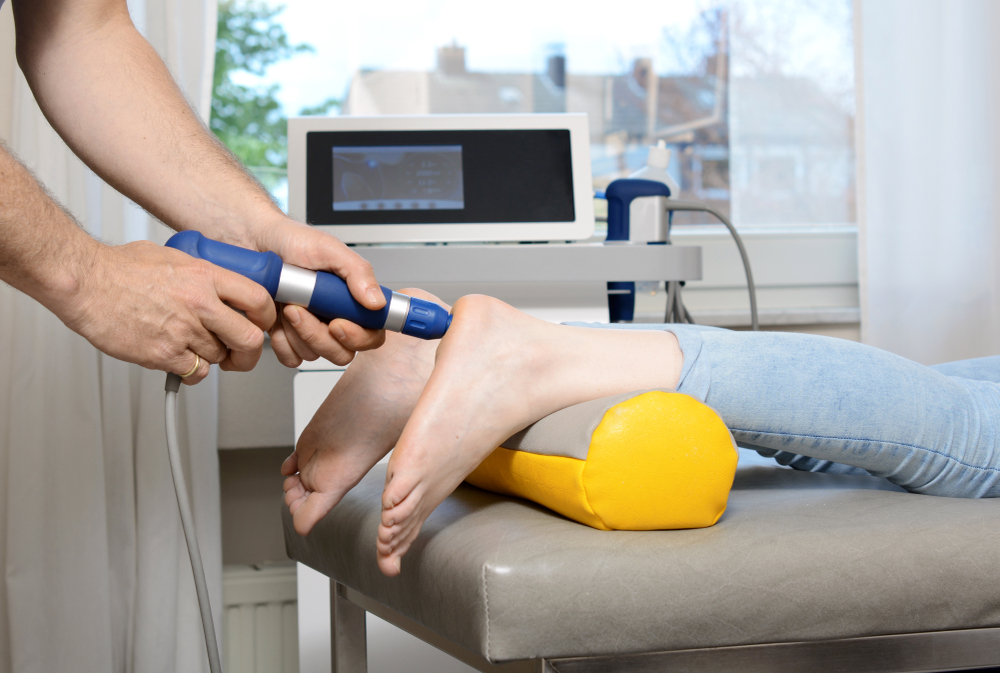
Chronic pain and injuries can be treated with ShockWave therapy. Indeed, the treatment may sound intimidating at first, but ShockWave therapy for the feet is a non-invasive method that works by stimulating the body’s natural healing responses. It’s a preferred treatment for those who want to avoid surgery and medication. Here’s a rundown of the therapy to help you make an informed decision
What is ShockWave therapy for the feet?
n some cases, boosting the tissue’s inflammatory response can encourage healing. And while inflammation may not produce the most comfortable sensation, it’s the immune system’s natural response to infection or injury. When not chronic or extreme, inflammation can be quite beneficial, and it’s this principle that ShockWave foot therapy is based upon.
So, what is ShockWave therapy exactly? Simply put, vibrations produced by the ShockWave therapy machine propagate through the skin into underlying tissue. These radial acoustic waves (waves from a single source that spread in many directions) create microtrauma in bone, muscle, or ligament of the treated area. The damaged tissue is naturally and gradually destroyed while the body regenerates new cells.
The waves interact with pain neurotransmitters during the procedure, providing immediate relief. ShockWave therapy improves blood circulation, stimulates collagen production, accelerates healing, and offers long-term pain relief.
When is ShockWave therapy recommended?
Your chiropodist may suggest ShockWave therapy for injuries that are slow to heal or for chronic inflammation-related pain. Usually, these conditions are first treated with exercise. You may also be prescribed pain-relief medication, or the affected limb may be corrected with gentle manipulation. However, the body sometimes needs a push to mobilize resources that promote natural healing. This is where ShockWave therapy comes in—it’s for people suffering from an injury or pathology for several months.
Achilles tendonitis, heel spurs, plantar fasciitis, or bursitis can be successfully treated with shock waves. This treatment can also address foot injuries that aren’t healing well and creating adhesions. Finally, those with shin splints (a condition commonly affecting runners) or nerve-related problems such as Morton’s neuroma can receive long-term relief thanks to ShockWave therapy.
Advantages of ShockWave therapy for the feet
ShockWave therapy is non-invasive, meaning it doesn’t require access to internal tissues via surgery. Depending on the condition being treated, its effects can be felt after the first few sessions. Usually, it takes between one and three months to achieve its full benefits.
The procedure happens in a podiatric clinic and lasts only a few minutes. Medication is not usually required, mainly because the inflammatory response should not be suppressed. In addition, there’s no need to immobilize the treated area. On the contrary, your chiropodist will prescribe exercises to maintain mobility and tissue elasticity, ensuring the best possible conditions for healing. It’s crucial to follow your chiropodist’s instructions to avoid recurrence.
ShockWave therapy contraindication
Since the process produces microtrauma on the tissues, the patient must receive a thorough examination beforehand to assess the presence of vulnerable tissue and avoid unwanted damage. The therapy is only offered when pain can be precisely located. Therefore, if the patient suffers from diffused pain where the precise source cannot be identified, ShockWave therapy is not administered. Furthermore, the healthcare professional must be informed if the patient has cancer, is taking anticoagulant medication, or has undergone a cortisone injection in the previous months. Additional ShockWave therapy contraindications include pregnancy, diabetes, and immunocompromised patients or those with cardiovascular problems.
How is ShockWave therapy administered?
Once the patient is okayed as a good candidate for ShockWave therapy, the chiropodist identifies the treatment area by palpating the foot. Next, a gel is applied to the area, and the ShockWave therapy machine’s pulse frequency is determined. Usually, pulses begin at a lower frequency and gradually increase. The session can be uncomfortable but only lasts a few minutes.
When done, the patient can return to their routine, being mindful not to overload or overstress the foot. In the hours following the treatment, pain, swelling, and bruising may occur. A healthcare provider should be informed if these symptoms worsen or persist beyond 48 hours. A follow-up is usually performed within the same week, with subsequent treatments scheduled weekly. The chiropodist determines the number of treatments required depending on the condition.
ShockWave therapy alternatives
Before prescribing ShockWave therapy, your chiropodist may offer gentler treatments to correct posture and improve foot stability. Manual therapies, rehabilitation exercises, and custom orthoses are often favoured as they restore musculoskeletal balance, relieve pressure points under the arch, and heal inflamed tissue. These treatments do not interfere with your daily life and are highly effective when promptly administered. More intense pain can be relieved with medication, and in the most severe cases, cortisone injections are administered to provide long-term relief.
ShockWave therapy near me: Treat foot pain at a FootNetwork member clinic
While ShockWave therapy has proven successful, it’s sometimes most effective as part of a broader treatment plan. We’re committed to providing you with the best possible services to ensure healthy healing while mitigating foot pain. Contact your nearest FootNetwork clinic to make an appointment.

